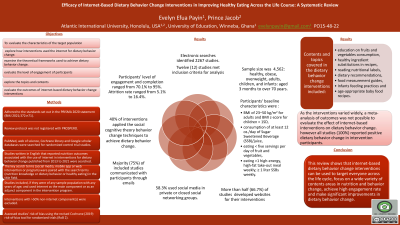Back

Objectives: To assess the efficacy of internet-based dietary behavior change interventions in improving healthy eating across the life course.
Methods: This systematic review adhered to the standards set out in the PRISMA 2020 statement: an updated guideline for reporting systematic reviews (BMJ 2021;372:n71). The review protocol was not registered with PROSPERO. PubMed, web of science, Cochrane library and Google scholar databases were searched for randomized control trial studies reported nutrition outcomes associated with the use of internet in interventions for dietary behavior change published from 2013 to 2021. Authors screened, read and extracted data from the articles using eligibility criteria. Authors assessed the risk of bias in each RCT employing the revised Cochrane (2019) risk-of-bias tool for randomized trials (RoB 2).
Results: Twelve studies met inclusion criteria. Sample size was 4,562 participants aged 3 months to over 70 years. Majority 66.7% of studies used websites developed for their interventions. Majority (75%) of included studies communicated with participants through emails. The characteristics of participants at baseline were overweight, obese, consumption of at least 12 oz./day of Sugar Sweetened Beverage (SSB), eating ˂ five servings per day of fruit and vegetables, ˃1 high-energy, high-fat take-out meal weekly. About 40% of interventions applied the social cognitive theory behavior change techniques to achieve dietary behavior change. Attrition rate ranged from 5.1% to 16.4%. Participants’ level of engagement and completion ranged from 70.1% to 95%. Contents covered in the dietary behavior change interventions varied across studies. As the interventions varied widely, a meta-analysis was not possible, however all studies (100%) reported positive dietary behavior change in intervention participants.
Conclusions: This review shows that internet-based dietary behavior change interventions can be used to target everyone across the life cycle, focus on a wide variety of contents areas in nutrition and behavior change, achieve high retention rate and significant improvements in dietary behavior change. This is significant as face-to-face interventions are not possible with current Covid-19 pandemic restrictions and therefore a good alternative or replacement.
Funding Sources: Not funded
Global Nutrition
(PO15-48-22) Efficacy of Internet-Based Dietary Behavior Change Interventions in Improving Healthy Eating Across the Life Course: A Systematic Review


Evelyn E. Payin, MPhil
– PhD Student, Atlantic International University, Ipswich, England, United Kingdom- PJ
Prince Jacob
– Atlantic International University, Honolulu
Presenting Author(s)
Co-Author(s)
Disclosure(s):
Evelyn E. Payin, MPhil: No relevant financial relationship(s) with ineligible companies to disclose.
Objectives: To assess the efficacy of internet-based dietary behavior change interventions in improving healthy eating across the life course.
Methods: This systematic review adhered to the standards set out in the PRISMA 2020 statement: an updated guideline for reporting systematic reviews (BMJ 2021;372:n71). The review protocol was not registered with PROSPERO. PubMed, web of science, Cochrane library and Google scholar databases were searched for randomized control trial studies reported nutrition outcomes associated with the use of internet in interventions for dietary behavior change published from 2013 to 2021. Authors screened, read and extracted data from the articles using eligibility criteria. Authors assessed the risk of bias in each RCT employing the revised Cochrane (2019) risk-of-bias tool for randomized trials (RoB 2).
Results: Twelve studies met inclusion criteria. Sample size was 4,562 participants aged 3 months to over 70 years. Majority 66.7% of studies used websites developed for their interventions. Majority (75%) of included studies communicated with participants through emails. The characteristics of participants at baseline were overweight, obese, consumption of at least 12 oz./day of Sugar Sweetened Beverage (SSB), eating ˂ five servings per day of fruit and vegetables, ˃1 high-energy, high-fat take-out meal weekly. About 40% of interventions applied the social cognitive theory behavior change techniques to achieve dietary behavior change. Attrition rate ranged from 5.1% to 16.4%. Participants’ level of engagement and completion ranged from 70.1% to 95%. Contents covered in the dietary behavior change interventions varied across studies. As the interventions varied widely, a meta-analysis was not possible, however all studies (100%) reported positive dietary behavior change in intervention participants.
Conclusions: This review shows that internet-based dietary behavior change interventions can be used to target everyone across the life cycle, focus on a wide variety of contents areas in nutrition and behavior change, achieve high retention rate and significant improvements in dietary behavior change. This is significant as face-to-face interventions are not possible with current Covid-19 pandemic restrictions and therefore a good alternative or replacement.
Funding Sources: Not funded

.png)
